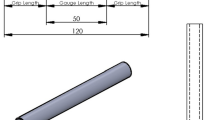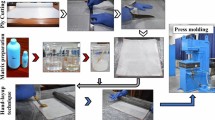Abstract
Tensile data on unidirectional composites generated from a flexure test usually yield a higher strength than observed from a standard tensile coupon. According to a statistical-strength theory based on a Weibull distribution, the presence of a stress gradient in the flexure-test results in an apparent increase in tensile strength as compared to the tensile test under uniform stress. In the present paper, this concept is explored by utilizing data from unidirectional graphite-epoxy composites to compare with theoretical results generated from a two-parameter Weibull distribution. A larger variation in tensile strength is observed from tensile-coupon data than from flexure data. Such differences are not in accordance with strength theories based on a uniform flaw distribution and raise questions concerning variability of the test methods, as well as sources of material variability.
Similar content being viewed by others
Abbreviations
- B(S) :
-
risk of rupture at stressS
- b :
-
width of test specimen, mm (in.)
- L :
-
length of tensile specimen or span of beam specimen, mm (in.)
- h :
-
thickness of test specimen, mm (in.)
- S :
-
maximum stress, MPa (psi)
- S b :
-
characteristic bending strength, MPa (psi)
- S o :
-
scale parameter in two-parameter Weibull distribution
- \(\mathop S\limits^ \wedge _0 \) :
-
maximum likelihood estimate ofS o
- \(\bar S_b \) :
-
adjusted maximum likelihood estimate for scale parameter under bending load, MPa (psi)
- S t :
-
characteristic tensile strength, MPa (psi)
- \(\bar S_t \) :
-
adjusted maximum-likelihood estimate for scale parameter under tensile load, MPa (psi)
- X :
-
normalized strength
- X o :
-
scale parameter for normalized strength
- X o :
-
maximum likelihood estimate of normalized-scale parameter
- α:
-
shape parameter in Weibull distribution
- \(\mathop \alpha \limits^ \wedge \) :
-
maximum likelihood estimate of shape parameter
- \(\bar \alpha _t \) :
-
unbiased estimate of pooled-shape parameter for tensile loading
- \(\bar \alpha _b \) :
-
unbiased estimate of pooled-shape parameter for bending
References
Weibull, W., “A Statistical Theory of the Strength of Materials,” Ing. Vetenskaps Akad. Handl (Roy Swedish Inst. Eng. Research Proc.), NR 151 (1939).
Bullock, R.E., “Strength Ratios of Composite Materials in Flexure and in Tension,”J of Comp. Matls.,8,200 (1974).
Daniel, I.M. and Weil, N.A., “The Influence of Stress Gradient Upon Fracture of Brittle Materials,” ASME Paper No. 63-WA-228, presented at Winter Annual Meeting, Amer. Soc. of Mech. Eng., Philadelphia, PA, Nov. 17–22, 1963.
Weil, N.A. andDaniel, I.M., “Analysis of Fracture Probabilities in Uniformly Stressed Brittle Materials,”J of the Amer. Cer. Soc.,47,268 (1964).
Knight, M. andHahn, H.T., “Strength and Elastic Modulus of a Randomly-Distributed Short Fiber Composites,”J. of Comp. Matls.,9,77 (1975).
ASTM Standard D-3039, “Standard Test Method for Tensile Properties of Oriented Fiber Composites,” Book of ASTM Standards, Part 36, 721 (1978).
ASTM Standard D-790, “Standard Test Method for Flexural Properties of Plastics and Electrical Insulating Materials,” Book of ASTM Standards, Part 35, 321 (1979).
Mann, N.R., Schafer, R.E. andSingpurwalla, N.D., Method for Statistical Analysis of Reliability and Life Data, John Wiley and Sons, New York (1974).
Thoman, Darrel R. andBain, Lee J., “Two Sample Tests in the Weibull Distribution,”Technometrics,11,805 (1969).
Wolf, R.V. and Lemon, G.H., Reliability Prediction for Composite Joints—Bonded and Bolted Air Force Technical Report AFML-TR-74-197 (March 1976).
Thoman, Darrel R., Bain, Lee J. andAntle, Charles E., “Inferences on the Parameters of the Weibull Distribution,”Technometrics,11 (3),445–460 (Aug. 1969).
Author information
Authors and Affiliations
Rights and permissions
About this article
Cite this article
Whitney, J.M., Knight, M. The relationship between tensile strength and flexure strength in fiber-reinforced composites. Experimental Mechanics 20, 211–216 (1980). https://doi.org/10.1007/BF02327601
Received:
Revised:
Issue Date:
DOI: https://doi.org/10.1007/BF02327601




